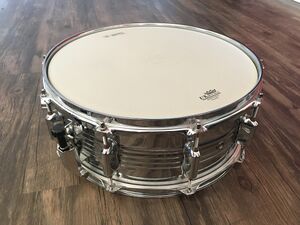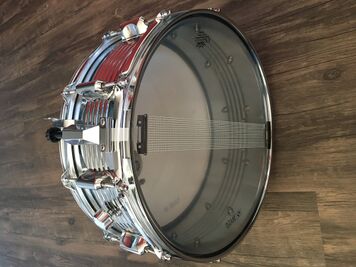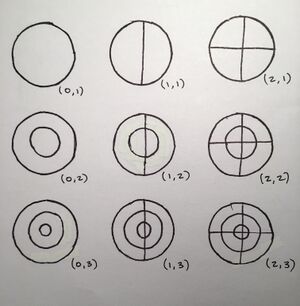Course:Phys341 2020/Snare drum
The snare drum is a percussion instrument that is played in a variety of environments, such as concert bands, marching bands, orchestras, and military, and is an essential aspect of a drum set. Also known as a side drum, it originates from the historical tabor drum that was used in medieval Europe mainly for military purposes.[1] It is played in an upright position typically with drumsticks, but can be played with other mallets such as brushes, to create different sounds.

Structure
The snare drums consist of two membranes (also known as heads), which are both stretched across a cylindrical shell. Metal rims cover the circumferences of both heads, with tuning rods placed at equal intervals around both rims. The tuning rods are connected to lugs, which can control the overall tension of the heads. A collection of metal wires (the snares) are attached across the resonant head (the lower snare head), and can controlled through a lever that is located on the side of the drum (the snare strainer). The top head is known as the batter head, and is the membrane that is hit to make sound. The resonant head is typically thinner than the batter head, to increase the energy that is transferred to the snare.[2] To be played, snare drums can either be placed on a snare drum stand or be suspended by a strap that hangs around a musician's neck.

Types of Snare Drums
There are various types of snare drums, depending on what timbre is desired and what environment it is intended to be used in. Most snare drums have similar diameters of around 14" (~35.5 cm).
Marching Snare Drum
Usually found in marching band ensembles, marching snares are one of the biggest snare types. Their depth can be as long as 12" (~30.5 cm), creating a deeper tone.[3] They are typically suspended through straps around a musician's neck or on their shoulders, allowing for the maximized possible motion of the player.
Drum Set Snare Drum
Designed to be part of a drum set, this snare type is smaller than the marching snare drum and has depths that range from 5" (~12.5 cm) to 8" (~20 cm). Within a drum set layout, it is typically placed close to where the musician sits down to play.
Concert Snare Drum
Is most often seen in concert and orchestral settings. Concert snare drums range in size, often having the same variety of dimensions as the drum set snare drum. However, due to its contrasted usage, the heads of concert snare drums (and sometimes their snares) are usually made with different materials.
Piccolo Snare Drum
Takes on the name 'piccolo' due to the shorter dampening time and higher perceived timbre it emits when played. In depth, it can be as shallow as 3" (~7.5 cm), and is most often seen as part of a drum set (rather than being used independently).
Functioning

The hollow area inside of a snare drum is a cavity of air that can be compressed. Hitting the batter head of the drum causes it to bend in its shape, which in turn compresses the air inside the shell. This compressed air causes the lower resonant head to change in shape and gain energy. As the energy in both heads travel across the membranes and are reflected back from the edges of the shell, their movements create simple harmonic motion. The vibrations that occur from this stimulate the snares on the resonant head, and excite the air within and around the drum (which creates sound).[4]
Due to having a 2 dimensional space in which energy waves and vibrations can travel, the snare drum modes in which simple harmonic motion occurs is unique to the drum category. Drums can resonant either circularly, across their diameter, or a combination of the two. These modes can be excited by hitting the drum on different points of the membrane. Wherever the drum is hit, an anti-node (an area with the greatest possible movement or energy) is created. By hitting a drum in its center, the (0,1) mode is most stimulated. Most higher modes have anti-nodes that occur outside of the center, and are therefore excited most when hit further away from the middle of the drum. Perceived pitch increases with the higher vibrational modes, suggesting that the closer to the edge one hits a drum, the higher the mode that is excited, and the more higher pitched overtones are heard (changes the characteristics of the sound that is created).[5]
Influences on Tone
When played, a snare drum does not make identifiable notes that can be differentiated. Instead, they emit multiple note at the same time, causing the stimulation of frequencies across the sound spectrum.[5] Although they can not change the frequencies they play once they are made (the sound spectrum does not significantly change with the excitement of different vibrational modes[6]), the snare drum's tone can be adjusted through various ways, according to what sound is desired.
Drum Shape

The volume of a drum determines its tonal qualities, and is influenced by two dimensions: depth and diameter. Increasing the depth or the diameter of the shell during a drums construction allows for more lower frequencies to be resonated, creating a deeper and heavier sound. Oppositely, making a drum that is smaller or shallower will make it more easily resonate higher frequencies, therefore creating a lighter and brighter sound.[4]
Materials
Snare drum shells are made of either metal or wood, with each producing different timbre characteristics. Wood shells tend to produce warmer and softer tones, and can be created from material such as birch, maple, mahogany, and poplar, in addition to others. In contrast, snare drums with metal shells create brighter and crisper sounds, and can be constructed from brass, steel, aluminum, copper, or bronze.[2][3]
The differences in tone between metal and wood categories (and between materials in each category) can be contributed to their varied reflective qualities and densities. Their interactions with both the drum heads and the resonating air induce a spectrum of tones.
The snares can also be made out of different material (such as acrylic, stone, and carbon fibre), but metal is the most common and usually the least expensive.
Tuning

Since the snare drum cannot usually change its sound spectrum or the 'notes' that it produces, tuning usually focuses on shifting the timbre that the drum produces. This is accomplished by tightening the heads by turning the tuning rods (increasing the tension of the membrane, thereby increasing the speed of the waves travelling across it). Tuning can also involve decreasing the dissonance that occurs when it is played, to create crisper and clearer sound. Dissonance problems can be improved by using the tuning rods to match the tension between lugs, in order to match the overtones that are emitted as close as possible. This will result in decreasing the number of total different overtones being played, creating a purer sounding drum.[5]
In addition, the tensions of the drum heads can be made intentionally the same or dissimilar, to influence the volume, tone, and length of sound.[4]
References
- ↑ Snare Drum, britannica.com. Retrieved March 24, 2020.
- ↑ 2.0 2.1 What are Drums Made of?, yamaha.com. Retrieved March 24, 2020.
- ↑ 3.0 3.1 Snare Drums, andertons.co.uk. Retrieved March 25, 2020.
- ↑ 4.0 4.1 4.2 How Sound is Produced, yamaha.com. Retrieved March 25, 2020.
- ↑ 5.0 5.1 5.2 About Drums, circularscience.com. Retrieved March 25, 2020.
- ↑ Modes of Vibration and Sound Radiation from a Snare Drum, asa.scitation.org. Retrieved March 25, 2020.